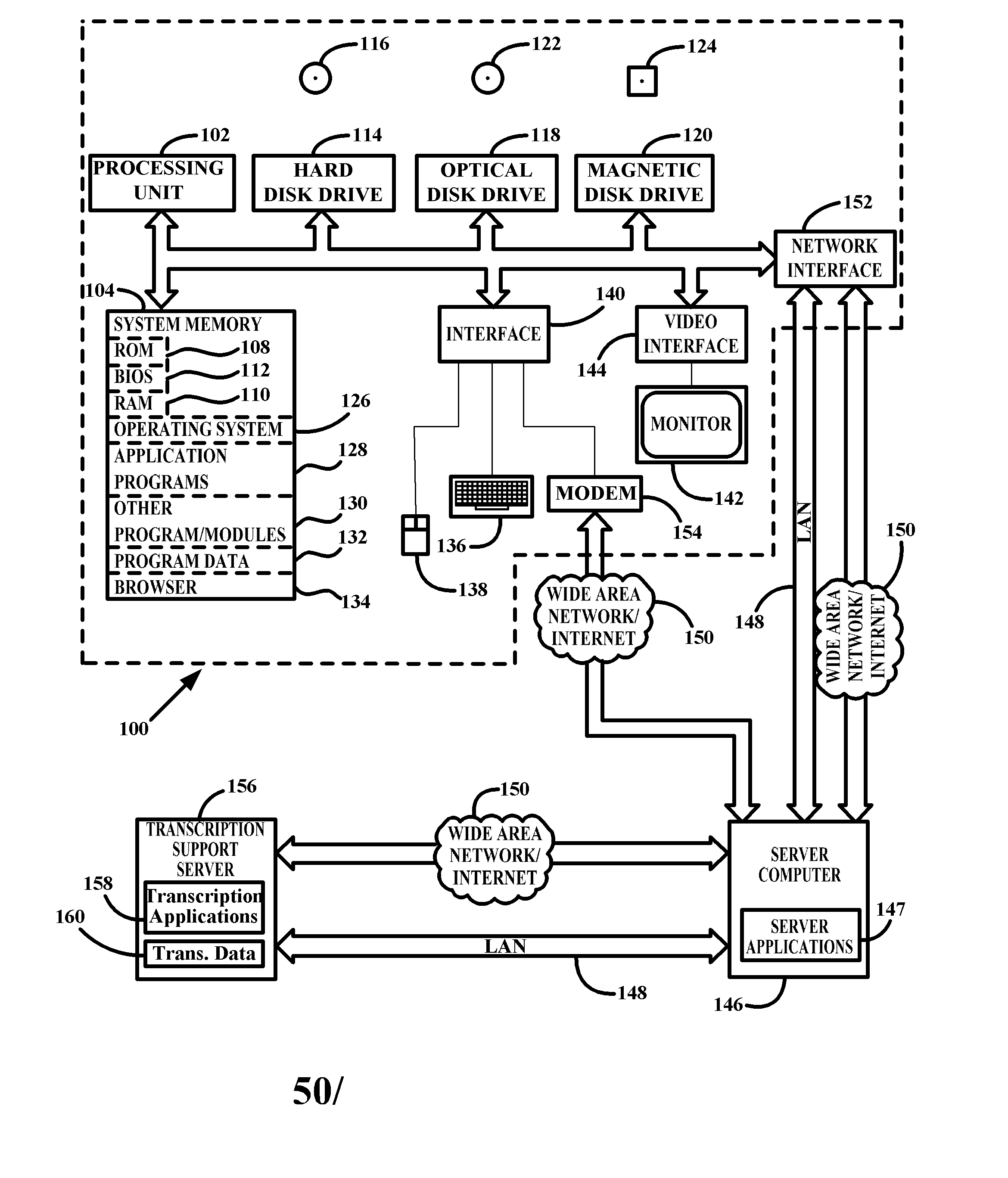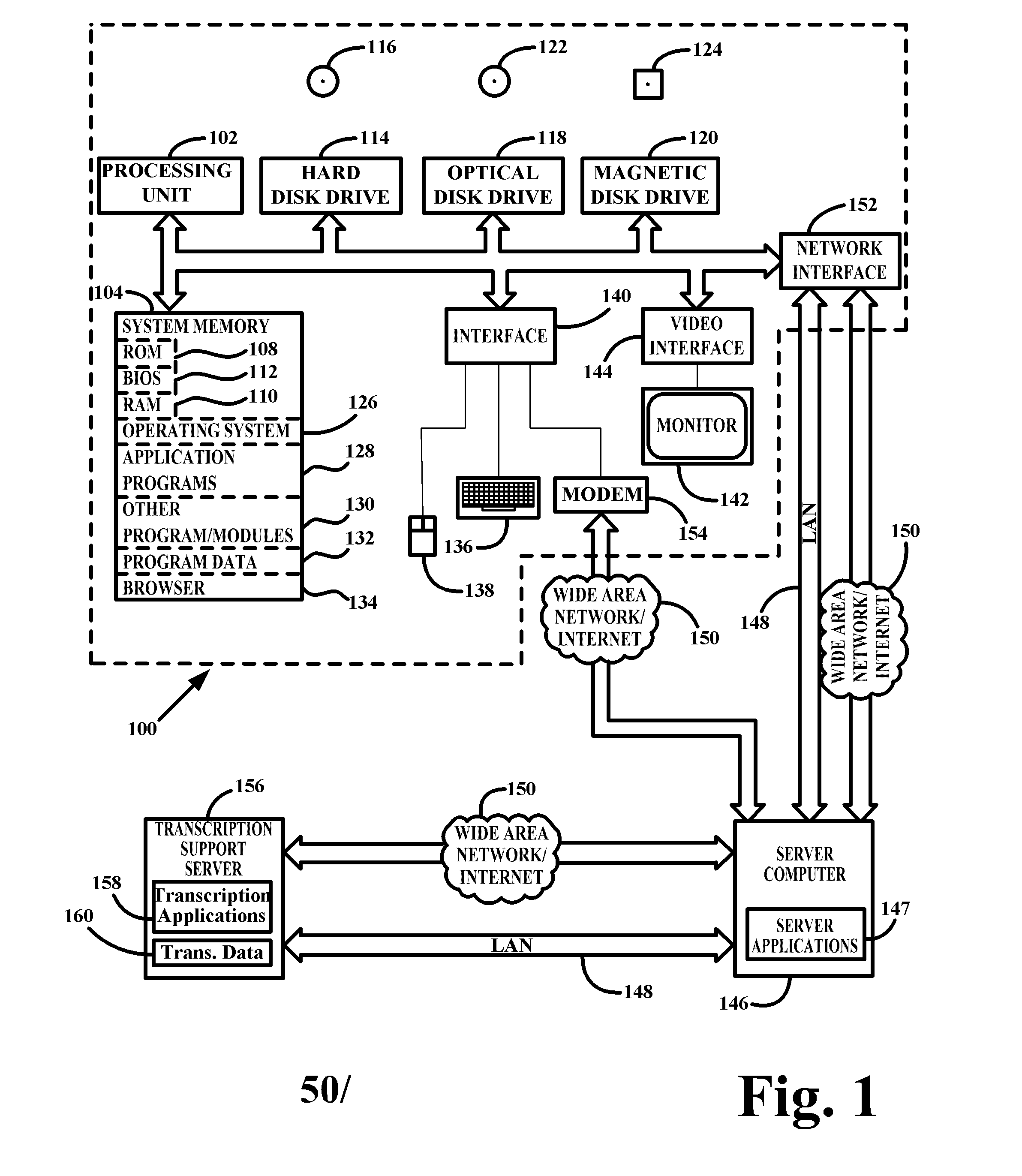EHR systems have the potential to improve both the quality and the efficiency of provided health care, however current EHR systems are generally cumbersome to use and offer little assistance to the health care provider.
Despite the recognition that EHR systems are in many ways compelling, their use is still met with a certain degree of opposition, skepticism, and limited success.
A barrier to ease of use and general usefulness of EHR systems is the difficulty of recording and integrating certain forms of data, such as the free-form text generally utilized to fully document a
patient encounter.
Therefore, although
dictation is generally acknowledged as easy and time-efficient for the person dictating, integrated approaches to this preferable function are lacking.
Therefore, it often takes longer to dictate using a
speech recognition software application than it does to dictate in a free-form manner to a human transcriptionist.
When providers use EHR systems that do not empower the provider to effectively use
dictation and transcription as a method of recording
patient data and where the provider still chooses to use this form of input, the EHR implementation often becomes contorted because of deficiencies of the
system and the workarounds employed.
The net effect is costly inefficiencies, failure prone workflows,
documentation delay, compromised EHR system value, and other negative consequences.
Those EHR systems that accommodate dictation and transcription most often do so as an afterthought, employing cumbersome methods and generally limiting the incorporation of transcribed data to elements of the
record that have little value in providing ongoing
patient care.
EHR systems which incorporate dictated and transcribed input in the EHR by utilizing the direct
input method (where the transcriptionist is required to type directly in the EHR) can consume valuable EHR
system capacity, network bandwidth, and create security vulnerabilities in the EHR; or be inefficient and unnecessarily tedious.
This consumes EHR
system capacity and network bandwidth, exposes more personal information to the transcriptionist than preferable, and, if using technology enabling a remote connection to the network over
the Internet, could possibly compromise the security of the network and EHR data.
This method is
time consuming, requires multiple personnel, and is expensive due to the cost of ‘double handling’ of the text.
EHR systems which utilize the dictation ‘marker’ approach to incorporate dictated and transcribed input in the EHR are prone to error and generally frustrate the effort to provide accurate transcription.
The approach is error prone because the ‘marker’ is not automatically linked to the dictation.
Any inaccuracy in this chain will cause the transcribed text to either be inserted into the EHR incorrectly (wrong place and perhaps wrong patient) or ‘orphaned’, requiring the provider or another system user to reconcile it.
In addition, the ‘marker’ makes providing accurate transcription more difficult because the dictation is only contextualized to the EHR and within the EHR through the ‘marker’, which provides little if any contextualizing data (such as
patient demographics, complaint, diagnosis, plan, etc.).
Regardless of recording method, no single system can be used to reconcile all dictated and transcribed text to the specific portions of the EHR for which the text is intended.
All of the contextualizing methods described and presently known in the art, offer little if any meaningful information to assist in the creation (
typing) of transcription.
Efforts toward accuracy by the individuals engaged in this work are significantly frustrated by a lack of
contextual information, making the work harder and less valuable to the provider.
Therefore, given the value of free-form text in fully documenting significant elements of
patient care, the provider's success in adopting and best utilizing EHR systems is hampered.
The net effect of this is slower EHR adoption, steeper learning curves for providers who do adopt an EHR system, and in many cases reduced provider efficiency when using an EHR system.
Another barrier to the ease of use and general usefulness of EHR systems by health care providers is the absence of interactive, contextualized, and annotated presentations of
health data over time or other controlling variables.
Historically in practice of
medicine, the graphical presentation of data in charts (line graphs, bar charts, pie charts, etc.) and flow diagrams (medication flow sheets, problem lists, etc.) was done manually through labor intensive, difficult, and error prone processes.
Together, these deficiencies effectively made the use of trended information by health care providers very limited as a practical matter.
While many EHR systems provide graphing and flow diagrams, they tend to replicate the historical limitations described above.
The current art of presenting information in EHR systems does not maximize the value of the correlated and finely parsed patient
health data recorded in the EHR nor do they allow for the manipulation and
annotation features that are possible by maintaining and accessing discrete data in a computerized
software application.
Therefore the use of trended information by health care providers is still limited as a practical matter.
Comparing data values over time and relative to each other and clinical or other events is particularly preferred in the proper assessment of the patient, yet this is very difficult to accomplish for the EHR system user.
Therefore, EHR systems are harder to use and less useful than they could be.
 Login to View More
Login to View More  Login to View More
Login to View More 


